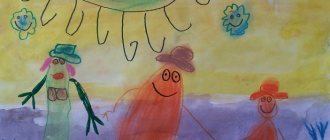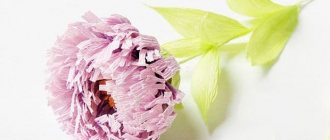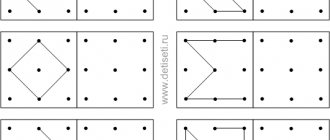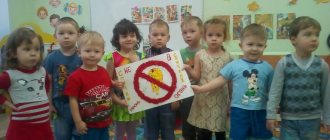Preparatory group. Senior preschool age. Children 6-7 years old
Summary of a lesson on appliqué with elements of drawing in the preparatory group “Bullfinch”
Goal: developing the ability to perform appliqué without templates according to a sample after explaining the sequence of work. Objectives: - expand children’s understanding of wintering birds; - develop the ability to convey your observations of living nature to...
Summary of a lesson on applique in the preparatory school group “New Year's felt boots”
Topic: “New Year's felt boots”
Tasks: continue to introduce children to New Year's boots; consolidate the skill of drawing up a pattern to decorate a felt boot, correctly positioning the pattern, carefully gluing it, working with scissors; develop children's creative abilities and imagination; develop…
Application “Autumn Leaves”
photo 1
In order to complete this master class, you need:
- scissors
- colored paper
- pencil
- leaf outline templates
photo 2
The technique can be compared to the technique of cutting out snowflakes. First you need to take a sheet of green paper.
photo 3
It is folded in half and a triangle is obtained.
photo 4
After this, the triangular-shaped workpiece is folded in half twice more.
photo 5
photo 6
At this stage you need to apply a template of an oak leaf image.
photo 7
This sheet is traced along the contour using a simple pencil.
photo 8
photo 9
Appliquing autumn trees from paper is quite simple. In order to make a birch leaf, it is better to take a yellow sheet of paper. The sheet is folded in exactly the same order.
photo 10
It is necessary to trace the outline of the leaf according to the template and cut it out.
photo 11
photo 12
In order to cut out a maple leaf, you need to take an orange sheet of paper.
photo 13
It is folded in the sequence indicated above.
photo 14
A maple leaf template is applied to the workpiece, folded in half, traced, and cut out.
photo 15
After this, the leaves are unfolded and glued to paper. Even an adult will like this version of autumn snowflakes. The craft will be an excellent decoration for a kindergarten room.
Hedgehog
Applications for the little ones are creativity, where the abilities of even the tiniest fidget are taken into account. And this example with the “hedgehog” is just right for toddlers who, by the age of three, still cannot cut and glue, but they will be great at participating in the work. How?
- There are two options for preparing to make this applique for kids. First
.
We trace the baby's palm on a sheet of black or brown paper. Cut it out. Glue it. Four palms will be enough. Second option
. Or we use finger paints. The child dips his palm, and we help him put his palm in this way several times, at different angles in the upward direction, to make a fan. - Cut out something like a boat from paper of the same color. This is the body and nose of the hedgehog (cut out a small circle and glue the “nose” to the edge of the muzzle).
- We place the body under the “needles”.
- You can draw a mouth and an eye, or make semicircles from red and white paper. Don't forget about the pupils.
- Paper applications would be incomplete without a plot. We come up with a story with the baby. Our hedgehog is coming from the forest, so we’ll cut out and glue his “prey”: an apple and a mushroom.
- We complement the paper applique with small black paws.
Application “Magic autumn”
Children love to watch nature. And they probably note that the trees dress in unusual outfits. Next, work will be presented that develops not only fine motor skills, but also observation, imagination, and fantasy. Since the autumn application is simple, the kindergarten preparatory group performs it independently, under the supervision of a teacher. The following materials will be required:
- blue printing paper,
- multi-colored printing paper,
- marker,
- glue.
First you need to take blue paper and a marker. Use a marker to draw a tree trunk and branches. Most often, students are asked to draw a birch tree. Next, the silhouettes of the leaves are cut out. The leaves are glued using a glue stick.
photo 16
You need to start creating a crown from the bottom. Next, a layer of leaves is glued closer to the tree trunk. But glue should only be applied to the edge of the leaf. Work continues until the entire tree trunk is completely covered.
photo 17
All that remains is to wait until the work dries.
photo 18
Plasticine
The joint creativity of a parent and a kindergartener has healing potential. In addition to the fact that work brings people together, it also allows you to:
- forget about problems and troubles;
- cope with a stressful situation;
- restore emotional state;
- express feelings and experiences in the project.
In addition, working with plasticine allows both adults and children to develop three-dimensional thinking. After all, you have to not only come up with an idea, but also bring it to life. It is important that the child takes an active part in the creative process. After all, working with plasticine develops:
- fingers;
- brain;
- memory;
- curiosity.
There are also combined crafts that are made from several materials in one work. These can be paper figures with plasticine elements or fairy-tale characters made from natural material and plasticine. Such works are attractive, unusual and beautiful. Thanks to them, it is possible to broaden the horizons and develop the child’s imagination.
Lessons like this allow you to teach preschoolers to think outside the box. At the same time, choose the most effective solutions in a particular situation.
The sculpting process takes time, but it is spent usefully. It is believed that this activity is fundamentally important in the process of teaching and raising preschool children. After all, during the exercise, the future student must imagine a full-fledged 3D model, feel the structure of the material and change the shape as it appears in fantasy.
Thanks to such master classes, creating crafts on a specific topic allows you to:
- develop a creative approach to solving a given problem;
- show a personal, individual attitude to a specific plasticine modeling object;
- learn to competently organize the process of working on a specific topic, for example, a picture of late autumn;
- work of such a plan teaches independence (after all, during its implementation, the future junior schoolchild determines the general task, sets goals, breaks down all the work step by step and completes the project);
- learns to adjust elements;
- Implementation of the plasticine modeling technique is an opportunity to develop fine motor skills of the hands.
Homemade plasticine crafts should be done together - parents and children. After all, such creativity is designed to calm you down and develop the skill of perseverance. If you conduct such an activity in the evening, then such a pastime will normalize sleep and reduce activity in a preschooler.
If ideas don’t come to mind or parents don’t have enough time when working together, then you can choose a work from photos - there are a lot of them on the Internet. In your search query, specify the topic. This will allow you to limit the selection from the bulk and select really interesting ideas for the project.







